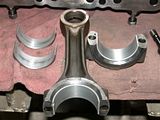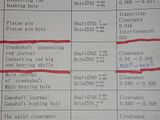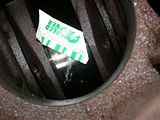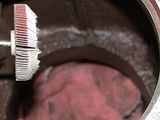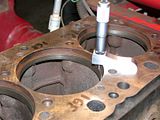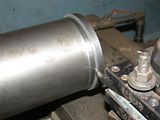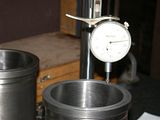3RRL
Super Member
- Joined
- Oct 20, 2005
- Messages
- 6,931
- Tractor
- 55HP 4WD KAMA 554 and 4 x 4 Jinma 284
Well, in fact I do have an update for you. I performed the leak test early this morning.
The 2 new valves passed the test 100%. The test is to pour kerosene (I used diesel) into the intake and exhaust ports .. fill them up and watch the valves for leaks. The valves should not leak for a minimum of 3 minutes. I tried to take some photos to show the fluid in the ports along with the valves. There was no leakage or seepage at all on the new valves so they passed with flying colors!
First photo is the new intake valve and second one is the exhaust valve.
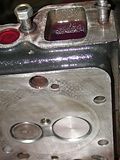
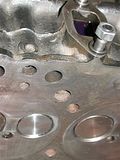
Sorry to say only one of the old valves passed the test (barely 2 min 45 seconds).
The others leaked within 45 seconds. I decided to use the rest of the new valves including replacing the marginal one. That meant starting over taking all the valve springs off again, and of course all that meticulous cleaning to do after lapping and bluing every one of them off, let alone the extra leak tests. Anyway, I figure I had a better chance of lapping them in correctly than chasing the old valves.
Plus the all the new valves seated within that depth tolerance better.
After I got the all the new valves completed and installed, I re-checked them with the leak test. Guess what, 2 intake valves still did not make the 3 minutes. I had to remove them ( a couple times) until I got all of them to pass the 3 minute no leak test. I'm glad I did and I'm proud of myself for taking the extra time to change them out even though I was tempted to say ... "ok, that's good enough". Especially after re-lapping and bluing those intake valves several times until they sealed 100%. Now I KNOW for certain they are all leak proof. But I also smell like a diesel fuel truck.
Photos below show leak if you look close, and second one of all the new valves installed.

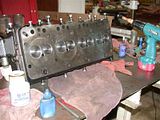
The 2 new valves passed the test 100%. The test is to pour kerosene (I used diesel) into the intake and exhaust ports .. fill them up and watch the valves for leaks. The valves should not leak for a minimum of 3 minutes. I tried to take some photos to show the fluid in the ports along with the valves. There was no leakage or seepage at all on the new valves so they passed with flying colors!
First photo is the new intake valve and second one is the exhaust valve.


Sorry to say only one of the old valves passed the test (barely 2 min 45 seconds).
The others leaked within 45 seconds. I decided to use the rest of the new valves including replacing the marginal one. That meant starting over taking all the valve springs off again, and of course all that meticulous cleaning to do after lapping and bluing every one of them off, let alone the extra leak tests. Anyway, I figure I had a better chance of lapping them in correctly than chasing the old valves.
Plus the all the new valves seated within that depth tolerance better.
After I got the all the new valves completed and installed, I re-checked them with the leak test. Guess what, 2 intake valves still did not make the 3 minutes. I had to remove them ( a couple times) until I got all of them to pass the 3 minute no leak test. I'm glad I did and I'm proud of myself for taking the extra time to change them out even though I was tempted to say ... "ok, that's good enough". Especially after re-lapping and bluing those intake valves several times until they sealed 100%. Now I KNOW for certain they are all leak proof. But I also smell like a diesel fuel truck.
Photos below show leak if you look close, and second one of all the new valves installed.



